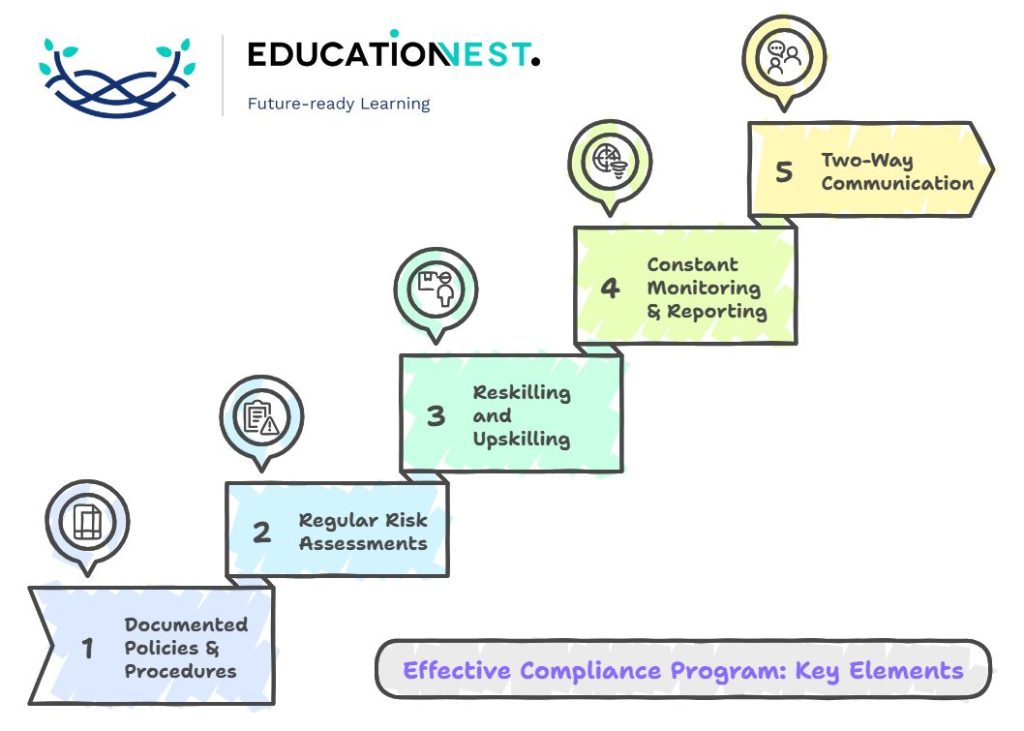The business market is dynamic, and so are the needs. Evolving tools and technologies, changing laws and regulations, and customer demands and expectations make it even more uncertain. However, ensuring compliance with the relevant industry and market standards helps ensure safe, secure, and successful operations. Investing in a good compliance program can help businesses reduce their unnecessary expenses.
Companies must educate and train their employees according to the latest compliance requirements. Education Nest can help with high-impact training that enhances key skills and competencies for better employee performance. It offers the best enterprise learning path for corporate growth and development and creates tailored solutions for maximum impact.
So, why is business compliance important? What are the key steps to create an effective compliance program? Read on to find out.
Why is Business Compliance Important?
Adhere to legal laws, regulations, policies, and standards to ensure business integrity and transparency. Companies must also establish internal frameworks to foster a strong organizational culture, prevent misconduct and violations, and promote ethical practices.
Also, different standards are prescribed at regional, national, and international levels to ensure fair market practices, employee treatment, workplace safety, and organized operations. Many of them are legally binding. Compliance failures can lead to severe implications, fines, and lawsuits. These are also associated with financial and reputational losses.
Some compliance frameworks are for business benefits only. The accelerated use of digital technologies has also increased the chances of security threats, data losses, breaches, and other such risks. Companies must follow standard security protocols to prevent these issues.
For instance, financial institutions should adhere to PCI (Payment Cards Industry) security standards for safe transactions. Similarly, insurance companies and healthcare providers must protect patients’ health information according to HIPAA standards.
Adhering to corporate compliance also improves business credibility and reliability. Customers prefer a company with a positive brand image and a healthy organizational environment. Therefore, businesses must act responsibly and take all necessary steps to comply with compliance requirements.

Effective Compliance Program: Key Elements
Compliance strategies should be designed with proper planning and implemented strategically for positive outcomes. Here are some key elements for creating effective compliance programs:
Documented Policies and Procedures
It is crucial to have every important rule, regulation, policy, framework, standard, and other corporate compliance requirements in writing. It avoids confusion and establishes clear guidelines for audits and assessments. Documentation ensures accountability and transparency. You can include these written records for your employee training to describe company expectations. Also, you must ensure accessibility to these documents for easy reference.
Regular Risk Assessments
Compliance is not a one-time process but rather a continuous one. It demands a detailed understanding of the corporate landscape, inherent risks, and potential issues. You must consider different aspects like regulation changes, technical advances, market demands, evolving business practices, and industry trends to gain valuable insights. You should constantly revise policies and procedures and make necessary adjustments for continuous improvements according to your employee needs, organizational goals and objectives, industry changes, and stakeholder and consumer demands.
Reskilling and Upskilling
As employees are at the core of all business, it is essential to keep them updated on compliance requirements. Since they are directly involved in the operational processes, they must be aware of the standard rules and regulations and quality expectations. Besides, there must be training for employee safety and well-being, anti-harassment, code of conduct, diversity and inclusion, and other such crucial areas.
Constant Monitoring and Reporting
To ensure effective implementation throughout the organization, you should constantly monitor and report compliance status. It will help you identify gaps and address them before they create severe problems. You can use compliance management tools and enable automated alerts and remediation, periodic reviews, and audits for greater organizational competency. It will help you prioritize risk areas and implement corrective action and remediation plans.
Two-Way Communication
For long-term sustainable results, you must enforce a strong compliance culture within your organization. One way is to foster two-way communication at all levels for proper coordination and cooperation. It is important to encourage employees to voice their concerns and questions. They must confidently report illegal conduct or compliance issues if they encounter any. It breaks down information silos and contributes to a positive work atmosphere.
Wrapping Up
Effective compliance programs are now a business necessity. It also adds a competitive advantage and positively impacts customer satisfaction. Additionally, a strong compliance culture promotes ethical behavior and practices, thus attracting more potential investors and business partners. It amplifies your credibility. As per recent reports, in the next five years, 91% of companies will be planning continuous corporate compliance.
The top priority areas are regulatory assessment, enhancing internal awareness, and training.
Education Nest can help you with the best corporate training in compliance. Check out our extensive course catalog to find high-impact training programs curated as per the latest market trends and requirements.
For more details, reach out to us today.
Read More
Corporate Compliance Training: Why It’s Essential for Employees?
Corporate Compliance in 2025: What Every Business Needs to Know
6 Compliance Challenges in 2025 & Strategies to Overcome Them
Top 10 Corporate Training Courses That Drive Professional Growth
